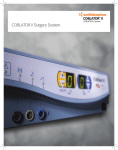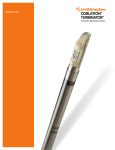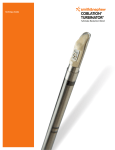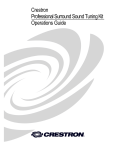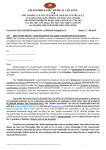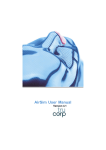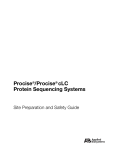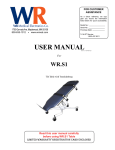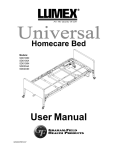Download Exel Radiofrecuencia abril 13 2015.cdr
Transcript
TECHNIQUE GUIDE Coblation for Laryngeal Lesions & Tracheal Procedures ® Coblation ® The PROcise® MLW Plasma Wand provides small lesion “Pin-point” ablation and coagulation capabilities Coblator ® II Surgery System Setup Set up the Coblator II System and the PROcise MLW Plasma Wand according to the Controller User's Manual and Wand Instructions for Use (IFU). NOTE: This guide is not intended to replace the Coblator II User’s Manual or Wand IFU. Thoroughly review the User’s Manual and Wand IFU before installing or operating this system. Default settings: Coblate 7, Coag 3. Adjust as needed and per surgeon preference. NOTE: Maintain the lowest power setting necessary to achieve the desired end effect. Active electrode Suction port Return electrode Saline delivery port Insulated shaft (outer diameter at tip 2.8mm) Connect the Wand's suction tubing to an OR suction source separate from any other suction instrumentation. Suction should be set to a lower setting (approximately 250 psi). Connect the Wand's saline tubing to bag of normal saline and adjust saline flow to a minimum intermittent drip. Patient/Other Preparation To ensure optimal visualization throughout the procedure, the Wand can be used with standard laryngoscopes and microscopes. Use the largest laryngoscope that can be accommodated. Particularly useful are those with proximally and distally adjustable blades. Standard cuffed microlaryngeal tubes are adequate for protection of the lower airways from any excess saline. This can be aided by gentle packing above the balloon with wet cottonoids. Chance contact of the Coblation Wand with the tube will not cause damage to the tube. NOTE: Recent studies about airway fires suggest that using Coblation technology in place of traditional electrosurgical or laser devices during oropharyngeal surgery significantly reduces risk of igniting an airway fire due to the low heat generated and the lack of spark or 1,2,3 ignition medium under normal operating circumstances. Special endotracheal tubes used with lasers are not necessary. Venturi ventilation has also been used successfully when Coblation is used. A head down (Trendelenberg) position should be utilized to ensure any excess saline flows into the pharynx and not the trachea. PROcise MLW Plasma Wand (EIC7071-01) TECHNIQUE GUIDE Procedure To ablate tissue, position Wand tip in close proximity to target tissue. CAUTION: Care should be taken in monitoring the targeted tissue during Ablation to ensure consistent and controlled tissue removal is maintained. Care should also be taken to ensure surrounding tissue is properly monitored. Due to the smaller anatomies of certain patients, carefully monitor the surrounding tissues to ensure tissue Ablation is localized to the targeted tissue. Press the ablation function (yellow pedal) of the Foot Control to activate the Wand. Make brief contact (1-2 seconds) with target tissue through the use of a dabbing motion. Continue Wand activation briefly after removing tip from target tissue to allow "digestion" of any tissue on the electrode surface before deactivating the Wand by taking your foot off the Foot Control. NOTE: Do not bend the Wand shaft or rub the Wand tip against target tissue during ablation as this could result in clogging of the suction line. Do not use the Wand suction line as a standard surgical suction device to clear debris from the surgical field as this could result in clogging of the suction line. To coagulate, position Wand tip directly over the source of bleeding and depress the Coagulation function on the Foot Control. After Thermal Effect (Animal Model ) 4 Thermal Effect 4 600 500 Depth (micrometer s) CAUTION: Keep active electrode directly facing target tissue. User should always pay close attention to the depth, orientation and coverage of the Plasma Wand, and to its proximity to surrounding untargeted tissue. Ensure non-targeted tissue does not contact exposed metal of active or return electrodes. Before 400 300 200 100 0 Default Coblate Maximum Coblate Default Coag Device Se ttings Histology (Animal Model ) 5 1 Smith LP, Roy S. Operating room fires in otolaryngology: risk factors and prevention. Am J Otolaryngol. Article in press (Epub 2010 Apr 14). References: 2 Roy S, Smith LP. Device-related risk of fire in oropharyngeal surgery: a mechanical model. Am J Otolaryngol. 2010 Sept;31(5):356-359. This article references preclinical non-human data. As such, results may not necessarily be the same in human procedures. 3 Matt BH, Cottee LA. Reducing risk of fire in the operating room using Coblation technology. Otolaryngol Head Neck Surg. 2010 Sept;143(3):454-5. 4 Data based on tongue tissue in an animal model; results may not be the same in humans. Data on file – report # 35764-01. 5 Data based on vocal fold study in an animal model; results may not be the same in humans. Data on file – report # 35766-01. eXel ® Renovación sin límites Default Coblate Setting Day 3 Calle 160 N° 8B-28 Piso 2 PBX: +57(1)4673657 USA +1 (713) 429-4367 Móvil: +57 (320) 2110729 [email protected] [email protected] Bogotá, Colombia www.eXelmedical.com Default Coblate Setting Day 21



